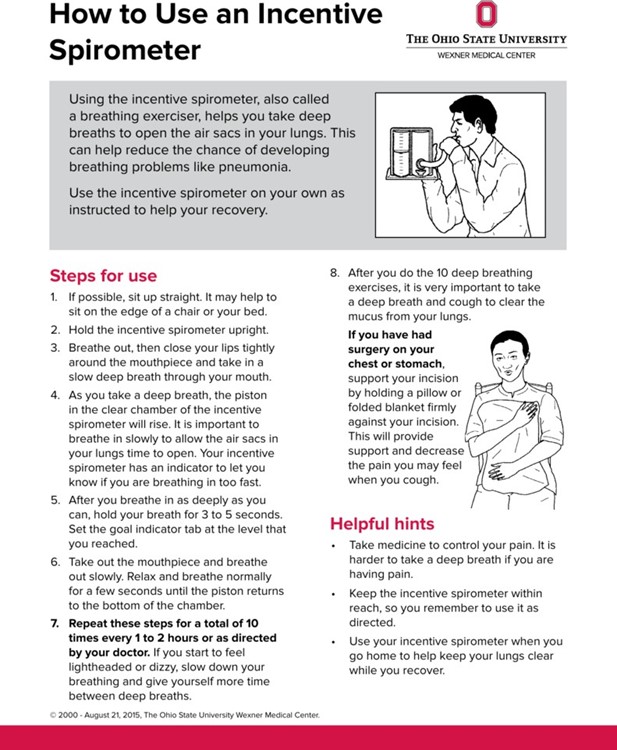A client is using an incentive spirometer on the first postoperative day after an inguinal herniorrhaphy. The practical nurse (PN) should reteach the proper use of the spirometer when the client demonstrates which action.
Blowing forcefully into the mouthpiece.
Exhaling slowly after two seconds.
Using a tight seal around the mouthpiece.
Sitting upright during the treatment.
The Correct Answer is A
The practical nurse (PN) should reteach the proper use of the spirometer when the client demonstrates blowing forcefully into the mouthpiece. The proper way to use an incentive spirometer is to sit upright, hold the spirometer upright, place your mouth around the mouthpiece, breathe out slowly, and then inhale slowly only through your mouth as deeply as you can. Blowing forcefully into the mouthpiece is not the correct way to use an incentive spirometer.
B. Exhaling slowly after two seconds: This is actually a correct action when using an incentive spirometer. The proper way to use an incentive spirometer is to exhale slowly before inhaling deeply.
C. Using a tight seal around the mouthpiece: This is also a correct action when using an incentive spirometer. It’s important to create a tight seal around the mouthpiece with your lips to ensure that you’re inhaling and exhaling only through your mouth.
D. Sitting upright during the treatment: This is another correct action when using an incentive spirometer. Sitting upright helps you to breathe more deeply and fully, which is the goal of using an incentive spirometer.

Nursing Test Bank
Naxlex Comprehensive Predictor Exams
Related Questions
Correct Answer is A
Explanation
A. Checking the medical record for the correct signed consent form prior to the examination is the primary responsibility of the practical nurse (PN). Ensuring that the consent form is properly signed and documented in the medical record is crucial for legal and ethical reasons before proceeding with any invasive procedure.
B. While explaining the examination is important, obtaining informed consent is the responsibility of the provider, not the PN. The PN can clarify information but should not be the one to explain the procedure in detail and obtain the signature.
C. Explaining the procedure to a family member and obtaining their signature is not appropriate, as consent must come from the client unless they are incapacitated. Family members cannot give consent for procedures unless legally designated as such.
D. While asking if the client understands the exam and the need for the consent form is a good practice for ensuring informed consent, the PN's responsibility focuses more on verifying that the consent has been properly obtained and documented.
Correct Answer is A
Explanation
A. Gather the procedure tray and equipment – The practical nurse should gather all necessary supplies for the healthcare provider to perform the thoracentesis efficiently. Preparing the equipment beforehand ensures that the procedure can start promptly and reduces interruptions for missing supplies.
Rationale for Incorrect Answers:
B. Cleanse the site and cover with a sterile towel – This action should be performed by the healthcare provider immediately before the procedure to maintain sterility. The PN’s role is to prepare equipment and ensure the client is positioned correctly.
C. Keep the patient NPO (nothing by mouth) and encourage them to void – While voiding may be encouraged before some procedures to improve client comfort, it is not necessary for thoracentesis. Additionally, keeping the client NPO is not required, as the procedure does not typically involve sedation that would necessitate this restriction.
D. Place the patient in an orthopneic position – This may be done just before the procedure, but the healthcare provider typically directs the final positioning. Initial positioning or seating at the bedside can be done, but orthopneic positioning should follow the provider’s instructions.
Whether you are a student looking to ace your exams or a practicing nurse seeking to enhance your expertise , our nursing education contents will empower you with the confidence and competence to make a difference in the lives of patients and become a respected leader in the healthcare field.
Visit Naxlex, invest in your future and unlock endless possibilities with our unparalleled nursing education contents today
Report Wrong Answer on the Current Question
Do you disagree with the answer? If yes, what is your expected answer? Explain.
Kindly be descriptive with the issue you are facing.
